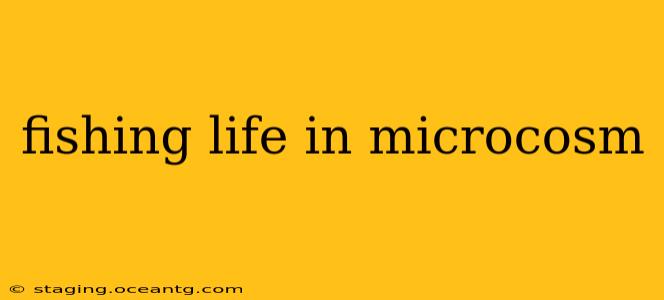Fishing. The word conjures images of tranquil lakes, roaring rivers, and the thrill of the catch. But beyond the postcard-perfect scenes lies a complex world, a microcosm reflecting broader societal trends and individual human experiences. This article delves into the multifaceted life of a fisherman, exploring its joys, challenges, and the vital role it plays in our ecosystems and cultures.
What Makes Fishing Life So Appealing?
The appeal of fishing life is multifaceted. For some, it's the solitude and tranquility found amidst nature's beauty. The rhythmic casting, the patient waiting, and the connection with the natural world offer a powerful antidote to the stresses of modern life. Others are drawn to the thrill of the chase, the adrenaline rush of a powerful fish on the line. The challenge, the skill involved, and the unpredictable nature of fishing make it a compelling pursuit. Beyond the individual experience, fishing can be a social activity, fostering bonds between anglers, families, and communities. Shared stories, friendly competition, and the simple pleasure of companionship enhance the overall experience.
What are the Different Types of Fishing Lifestyles?
The "fishing life" isn't monolithic. It encompasses a vast spectrum of experiences:
-
Commercial Fishing: This demanding profession involves navigating the complexities of the market, facing the challenges of unpredictable weather, and working long hours at sea to provide seafood for global consumption. The lifestyle is demanding, often requiring long periods away from home and a high degree of resilience.
-
Recreational Fishing: This encompasses a broad range, from casual weekend anglers to dedicated tournament competitors. The motivations are diverse, ranging from relaxation and stress relief to competitive achievement and the pursuit of trophy-sized fish.
-
Charter Fishing: This hybrid combines business acumen with a love for fishing. Charter captains navigate the intricacies of running a business while fulfilling the dreams of clients seeking a memorable angling experience.
-
Indigenous Fishing: For many Indigenous communities worldwide, fishing is not merely a pastime or profession; it's an integral part of their culture, spirituality, and sustenance, deeply intertwined with their history and relationship with the environment.
What are the Challenges Faced by People Who Fish for a Living?
Fishing for a living presents significant challenges:
-
Environmental Concerns: Overfishing, pollution, and climate change are constant threats, impacting fish populations and the livelihoods of those who depend on them.
-
Economic Volatility: The fishing industry is highly susceptible to market fluctuations, weather patterns, and regulatory changes, creating economic instability for those involved.
-
Physical Demands: The work is physically demanding, often involving long hours in harsh conditions and the handling of heavy equipment.
-
Safety Hazards: Commercial fishing is inherently dangerous, with risks associated with weather, equipment malfunctions, and the unpredictable nature of the sea.
How Does Fishing Impact the Environment?
Fishing's impact on the environment is complex and multifaceted. Sustainable practices are crucial to ensure the long-term health of fish populations and the marine ecosystem. Overfishing depletes stocks, damaging biodiversity. Bycatch, the unintentional capture of non-target species, poses a significant threat. Pollution from fishing gear and practices also contributes to environmental degradation. Responsible fishing practices, including adhering to regulations, using selective fishing gear, and minimizing bycatch, are essential for environmental sustainability.
Is Fishing a Sustainable Practice?
The sustainability of fishing depends heavily on responsible management and individual practices. Overfishing remains a significant problem, requiring stricter regulations and enforcement. Sustainable fisheries certification programs help consumers make informed choices and support environmentally responsible practices. Individual anglers can contribute to sustainability by following catch limits, using barbless hooks to reduce injury to fish, and practicing catch and release when appropriate.
What are the Future Prospects for Fishing?
The future of fishing hinges on addressing the challenges of overfishing, pollution, and climate change. Sustainable fishing practices, technological innovations in fishing gear and techniques, and collaborative efforts between governments, industries, and communities are crucial. A shift towards more sustainable aquaculture and responsible consumption habits will also play a significant role in securing the future of this vital resource.
In conclusion, the "fishing life" is a rich and complex tapestry woven from personal experiences, societal influences, and the delicate balance between human needs and environmental sustainability. Understanding these multifaceted aspects is essential for ensuring a future where fishing continues to thrive, providing sustenance, livelihoods, and a connection to the natural world for generations to come.
